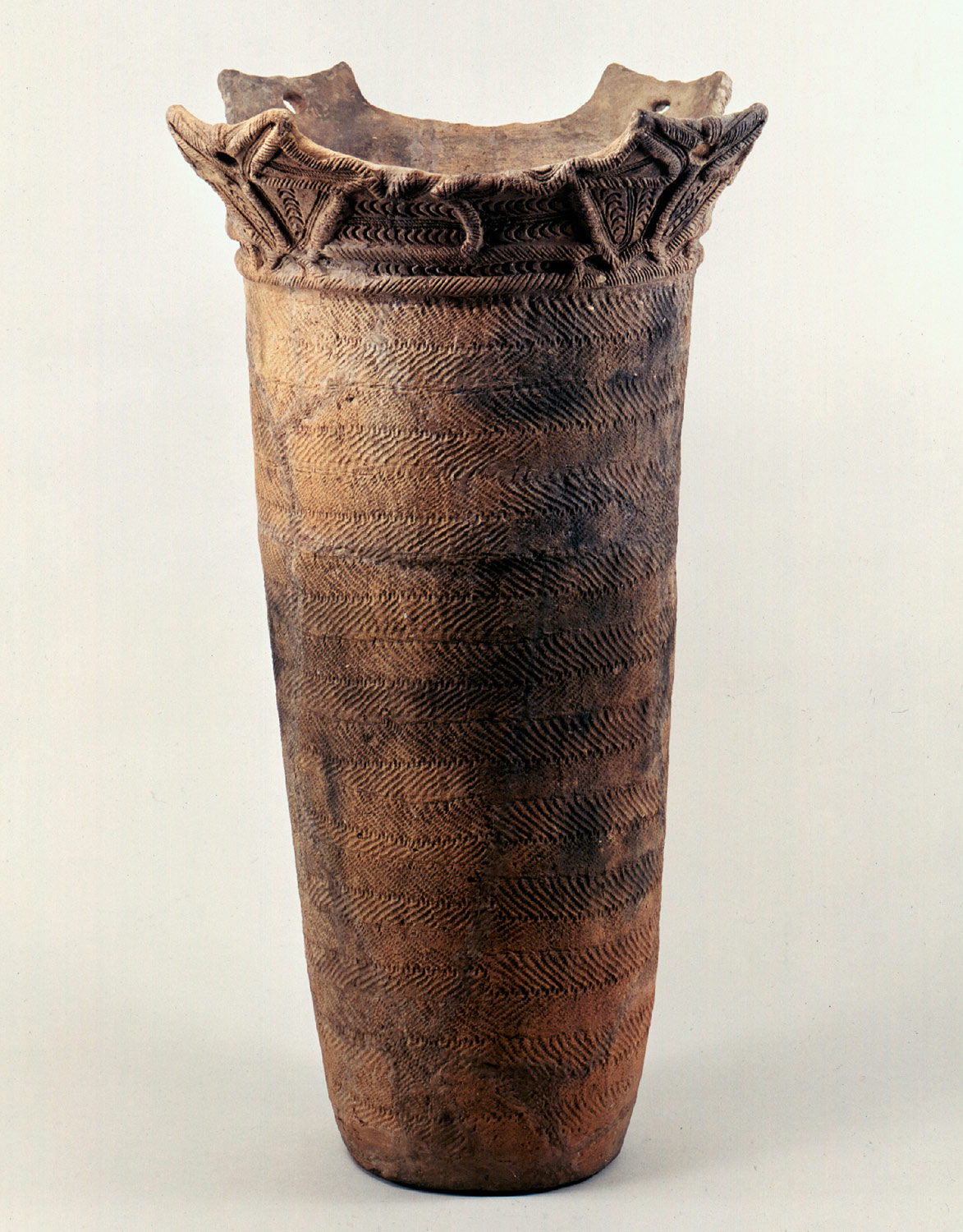Japanese pre-history is divided into what in Japanese archeological terms is called the "Pre-ceramic" period, and the "Jomon" period. The molding and firing of clay was a monumental technological advance among ancient peoples, and in the archipelago of Japan the ceramic arts may be said to mark the beginning of permanent settlement and the birth of an aesthetic culture. The Jomon people are not only credited with the first manufacture of serviceable clay pots, but at a very early stage of the technology’s development began decorating what they were making.
The first potsherds found in Japan were undecorated and date to the late Paleolithic period, approximately 15,000 years ago. The relative paucity of fired bits of such vintage suggest that while firing clay was known among Pre-ceramic peoples in Japan, the carrying of earthenware vessels was impractical given their nomadic ways. Based on the scant evidence, it is not well-established whether the Pre-ceramic peoples of Japan produced vessels or implements of some other unknown utility. The crude contour and smallness of the Pre-ceramic craft does suggest either a very prosaic or experimental view of the use of low-fired ceramics (see Kainer, Simon, "The Oldest Pottery in the World", Current World Archaeology, September 2003, pp. 44-49). However, the advent of pottery in Japan attends the first permanent settlements, the founding of agriculture and advances in social organization that would be understood as characteristic of the ascendant Jomon culture.
The elevation of pottery as a vital economic good during the 10,000 years of the Jomon period established one of the earliest man-made mediums of self expression, and a living cultural tradition still prized in modern Japan. Along with the pots themselves was something of
 far greater interest for our purposes here, namely, the ideas being expressed. The word Jomon is from the Japanese for “cord-marked” or “cord-marking,” or in some translations “rope-marked.” Whatever other practical uses rope may have been put to in Jomon culture (and one assumes that such uses were many), its entire epoch in Japan has been distinguished in name and artifact by an affinity for rope as an aesthetic good.
far greater interest for our purposes here, namely, the ideas being expressed. The word Jomon is from the Japanese for “cord-marked” or “cord-marking,” or in some translations “rope-marked.” Whatever other practical uses rope may have been put to in Jomon culture (and one assumes that such uses were many), its entire epoch in Japan has been distinguished in name and artifact by an affinity for rope as an aesthetic good.Japanese Pre-history, Briefly
It was on the Kanto plain in the vicinity of modern Tokyo that the first shards of Jomon creativity revealed themselves. Evidence of human habitation on the land mass that is modern day Japan dates to over 30,000 years ago during the last ice age when sea levels were significantly lower and temperatures much cooler, and Japan was connected to the Korean Peninsula and southern Siberia by several routes, or possibly a single expansive land bridge. The remains of flint tools consistent with late, or upper, Paleolithic technology have been found of the northern island of Hokkaido and the central island of Honshu, placing their makers not only in Japan, but also identifying them as nomadic hunter-gatherers with much the same seasonal ranges and tribal behaviors as their brethren to the west.
In most archaeological schools of thought pottery making is associated with the advent of agriculture; the fact of a harvest understandably necessitates a means of storing same, and thus does pottery appear in Mesopotamia around 7500 B.C.E. as grain cultivation developed and spread. The shard record reveals that the peoples of pre-literate Japan, however, began experimenting with pot making as early as 13,500 B.C.E., long before agriculture is known to have been introduced to Japan. The record also states pretty plainly that during this time these same people still organized themselves in small groupings, were nomadic and moved with the seasons following game. What small examples as exist tend to point to the manufacture of fist-sized spherical pots of no discernible utility - not capacious enough to store rice enough for even a single person’s daily needs, nor robust enough to use over an open flame. It is possible, therefore, to suggest that, in addition to being hard evidence of the earliest ceramic technology,
Pottery making is one of the markers of the Neolithic era in human history. We’ve already noted that the advent of ceramic technology in Japan reaches back to the upper Paleolithic era and may be the bridge event that prompts most scholars to suggest that the Mesolithic era of human technological development does not apply to Japan – culture went from Paleo to Neo directly. The heirs to the “Incipient” Joman, so-called owing precisely to their pot making, were the Jomon proper, literally, the “people of the cord.”
To be continued...

























